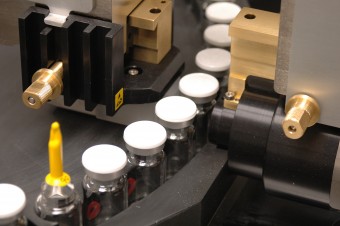Vacuum leak detection of freeze dried product
Regulatory guidance (Eudralex 2008) explicitly states that containers closed under vacuum should be checked for the maintenance of that vacuum. This guidance has led to the implementation of new types of inspection systems by the industry. Because headspace analysis can rapidly and non-destructively detect changes in the headspace conditions, it is a leading candidate to use as a vacuum leak detection method for finished freeze dried product.
.
Prior to sealing finished vials at the end of secondary drying a lyophilization chamber is backfilled to a gas pressure that is specified for the vial headspace. The specified headspace pressure varies from product to product and can range from full vacuum (0 mbar absolute headspace pressure) to a partial vacuum (typically 800 mbar absolute headspace pressure). The vacuum level serves the practical purpose of helping to seat the stopper and to facilitate reconstitution. Once the gas pressure in the vial headspace matches the chamber pressure, the shelves are lowered to seat stoppers into the vials. At this point the vial closure integrity is established but not considered complete until the aluminum overseal is applied. Once the shelves are raised, the seal integrity must be maintained for a period of time ranging from minutes to hours to possibly days before unloading and capping occur. It is possible during this time for stoppers to pop-up allowing gas ingress to the vial headspace. Stoppers can pop up due to a number of reasons including improper seating during shelf lowering, out of specification stopper and/or vial flange dimensions, and stopper coatings.
.
If seal integrity is lost during this time period then the physical properties of the headspace (gas pressure and/or composition) will change because gas from the ambient environment outside the vial will ingress into the vial headspace. Two common situations serve to illustrate the point. If the vial is exposed to a nitrogen atmosphere, for example prior to unloading from the freeze dryer, then nitrogen gas will enter the headspace causing the pressure to rise. If the vial is exposed to an air atmosphere, either because the chamber was vented with sterile air or the vial was exposed to room air prior to capping, then air will ingress into the vial causing both the pressure to rise and the oxygen concentration to rise. The practical implications of lost seal integrity are threefold. First, the headspace pressure rises which may impact the ability to reconstitute the product and would likely result in a customer complaint. Second, if the product is oxygen sensitive then air ingress will result in oxygen exposure and potentially impact the product stability. Third, if container closure integrity is breached then sterility can no longer be assured.
The LIGHTHOUSE benchtop headspace analysis systems and automated lease systems for 100% inspection are useful for packaging development studies or off-line verification of vacuum in containers sealed with an underpressure. These systems are validated and in routine use for monitoring container closure integrity in freeze dried product and in particular addressing the stopper pop-up issue.

